Tag: Cab Franc
The Year of the Sorting Table
Following up on my last blog, which concerned Cab Franc, Tim Mondavi, and the 2011 vintage in Virginia, among other things, I just read Emily Pelton’s article on the 2011 harvest in Grape Press, the publication of the Virginia Vineyards Association, and I am somewhat more hopeful about this vintage.
First, some introductions. Emily Pelton is the winemaker extraordinaire at her family’s
vineyard in Nelson County, Veritas Vineyard and Winery. And the Virginia Vineyards Association is the indispensable organization for anyone in the Commonwealth interested in viticulture and winemaking. The November issue of the Grape Press was one of the best I've read. In fact, I think I read every word, from beginning to end, and it was all good.
In any event, I spent part of my last post lamenting the difficult weather conditions, particularly the abundant rain that created all kinds of problems in the vineyard. One of the difficult decisions that winemakers and vineyard managers make as harvest approaches is how willinging they are to gamble on the weather. If rain is in the forecast, do you hold out a little longer, hoping the grapes will achieve the perfect balance of sugar and acidity, or do you pick early, sacrificing a bit of brix for the certainty that you will at least have a harvest? Continue Reading–>
Tim Mondavi and Cabernet Franc
We’ve been pretty sure for a while now that Cabernet Franc was a good bet for our small vineyard. It’s a wonderful grape for blending, often used to soften the harsh tannins in its close cousin, Cabernet Sauvignon, and it is lovely on its own as a varietal. And we’ve tasted it at enough wineries in enough different parts of the state to believe that it’s well suited to the growing conditions found in Virginia.
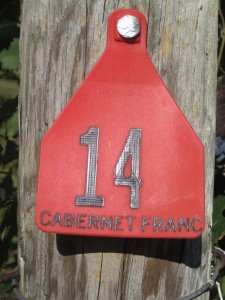 It is (usually) the dominant grape in Cheval Blanc, one of the great wines of Bordeaux. It is not a first growth, since Saint-Emilion was not included in the 1855 classification, but in the 1955 Saint-Emilion classification, it was one of two ones to be ranked as a "Premiers Grands Crus Classés A." And, of course, the 1961 Cheval Blanc was the wine that Miles had hidden away for a special occasion in Sideways. (He drank it from a paper cup at the end while at a McDonalds, since his love interest had told him that — and I'm paraphrasing from memory — any time you drink a Cheval Blanc, it's a special occasion.)
It is (usually) the dominant grape in Cheval Blanc, one of the great wines of Bordeaux. It is not a first growth, since Saint-Emilion was not included in the 1855 classification, but in the 1955 Saint-Emilion classification, it was one of two ones to be ranked as a "Premiers Grands Crus Classés A." And, of course, the 1961 Cheval Blanc was the wine that Miles had hidden away for a special occasion in Sideways. (He drank it from a paper cup at the end while at a McDonalds, since his love interest had told him that — and I'm paraphrasing from memory — any time you drink a Cheval Blanc, it's a special occasion.)
For those of you willing to spend upwards of $1,000 a bottle (and more) on a Cheval Blanc, I have no doubt you will feel the money well spent. But if you do, then don’t hesitate to invite me to share it with you. I’ve never tasted Cheval Blanc, but I’ve certainly lusted over the thought.
However, if you are among the 99 – make that the 99.9 – who can’t afford Cheval Blanc, you should think about a Virginia wine that is either entirely Cab Franc or included as the dominant grape in a blend. Almost every winery in Virginia seems to have a Cab Franc in its tasting room, and many of them are splendid.
But while we’re sold on Cab Franc, it’s always nice to hear that others feel the same way. In the Nov. 15 issue of The Wine Spectator, a lengthy article on Tim Mondavi includes a sidebar (The Francophile in Continuum,) that highlights this great winemaker's love for Cab Franc.
"The wines that had the highest percentage of Cabernet Franc were the wines I loved the most," says Tim. "When I would be looking at the wines in barrel, I found there was a higher perfume [in Franc] that was very different from Cabernet Sauvignon. It also adds viscosity and suppleness you can't find with Cabernet Sauvignon or Merlot."
Franc does need to be ripe, the Wine Spectator adds. “Otherwise it can be herbal, stalky and coarse.”
That’s precisely the problem that some identify in Virgina reds – vegetal flavors, usually produced by a compound known as methoxypyrazine that comes from grapes that are not quite ripe. The risk is especially pronounced in areas with short growing seasons or in years when rain or other conditions force an early harvest. Done right, Cab Franc can be wonderful, in Virginia wines as well as in Mondavi’s Continuum.
In another four years, after the vines have matured, the grapes have been picked and fermented, and the wine has been in the bottle for a suitable period of time, I’ll be able to tell you how well it worked out.
A night in the Vineyard — with Snow
Before explaing why we found outselves in the vineyard late last night with the snow coming down, let me give you a little background, which hopefully will assure you that we are not crazy. Not completely, anyhow.
In my last post, I talked about the importance of weather in vineyard management. Obviously weather is a factor in all things agricultural – there’s not a farmer in the world who doesn’t keep at least one eye on the sky throughout the growing season – but it raises very specific and difficult issues when it comes to viticulture. Vines, after all, aren’t annual crops. It takes three or more years to bring vines to the point where a crop can be harvested, and they can be be expected to bear fruit for decades after that, which means they must be nurtured through hot, humid summers and cold winters.
I also talked about the importance of site selection in my last post, and it turns out that many of the issues in selecting a vineyard property boil down to coping with weather.
For example, a late frost can cost you an entire growing season. No grapes, no wine, and (if this is your business), no money – although you’ll still have to undergo the expense of caring for the vines throughout the growing season And a serious winter freeze – one in which temperatures drop well below zero – can cost you the entire vineyard. That’s why wine-grape growers in Virginia look for property with an appropriate elevation. In much of the area east of the Blue Ridge Mountains, elevations above 800 feet are highly desirable, since they bring you into a sweet spot of a thermocline where warmer air is trapped. Optimal elevations, those within a thermal belt or thermocline, vary by region. In our area (the Monticello AVA), I believe that elevations of 800 to 1500 feet above sea level (ASL) are optimal. Any higher or lower and you risk problems from frosts and freezes. Continue Reading–>
Bringing in the Grapes — Part V
Readers of ProjectSunlight have noted a recurring theme over the past month. The weather, at least insofar as vineyard mangers in Virginia are concerned, really sucked this year.
It may be small comfort to the Commonwealth’s vignerons, but the weather has generally sucked worldwide. Jancis Robinson, in her Financial Times column last weekend, detailed the carnage in California and Europe, and even in the Southern Hemisphere, where the growing season is reversed.
“If Europe’s vintners have found 2011 much more trying than any other recent vintage, six months earlier, while picking their 2011s, the Australians experienced the vintage from hell,” she wrote. “Harvest time in the supposedly sunny wine state of South Australia was sodden. Winemakers have had to work extremely hard in some areas to fashion drinkable wine out of bloated, rotten grapes.”
And it goes beyond Australia. “The vintage in New Zealand was bloated too, thanks to frenzied recent planting of vines there, fuelled by a belief that the world is in love with Kiwi Sauvignon Blanc,” she added. “Argentine growers were also afflicted by rain at harvest time in 2011, as well as the usual hail, and unusually late frost in November last year.”
So, weather-related problems span the globe. As I’ve noted before, that’s the way it is with agriculture. You really have no control over the weather, although you can compensate to some extent – to a great extent in normal years, less so in years like 2011 – with a disciplined spraying program.
And winemakers can exert some magic of their own once the grapes come in. This year will be difficult for sure, and none of the winemakers I’ve spoken to have any illusions about the challenges ahead of them. This vintage will definitely separate the men from the boys, so to speak, and show, as Ms. Robinson said, “who exactly are those master craftsmen.”
Bringing in the Grapes – IV
The harvest is so full of unknowns. You never know exactly when the grapes will ripen – when the pH, Brix, tannins, flavor, and so many other variables will all be perfect – and so vineyard managers study the vines each day as
the growing season nears the end, squeezing juice from a random selection of grapes onto the refractometer, checking the seeds, examining the skins, measuring the pH, tasting the juice, and no doubt thinking, “Why me, God – why do You make me suffer each fall?”
But of course, that’s what makes viticulture the wonder that it is. Each season is different. So much work goes into growing the grapes and then so much judgment and so much hope goes into the decision about when to harvest.
Without a doubt, this has been the most difficult growing season in memory in Virginia. It’s hard enough to fathom out the date when the grapes will achieve the perfect balance of sugar and acid, without the additional complication that comes from weather. Consider this: If the grapes will be perfect on Wednesday, but it rains on Tuesday, then you probably would have been much better off picking on Monday, when they were a few days shy of perfection.
And here’s another twist: if it rains on Sunday and Monday, and the grapes swell from the
precipitation, you might think it wise to wait until Thursday or Friday to give them a chance to recover. If the sun comes out and stays out, you will think yourself a genius. But if it rains again, you may curse your stupidity.
Rain causes so much trouble at harvest. The grapes swell and split, bees attack, and the vineyard is ravaged by sour rot and botrytis. Botrytis is a problem, but it can be dealt with in the winery. Sour rot is different. You can see it and smell it, a sour vinegary odor that is apparent in the juice that breaks out of the berries and covers your hands. It’s best to let those grapes fall to the ground.
Every year brings something new, and this year when we arrived at DuCard Vineyards to pick Cab Franc, it was unseasonably cold. The thermometer read 47 degrees when we woke, and didn’t get above 50 until 8 a.m. At that temperature, it would be hard to get the grapes to begin fermenting, so we waited until 10 a.m., after the morning had warmed up just a bit, to start picking.
And what a glorious day it turned into!
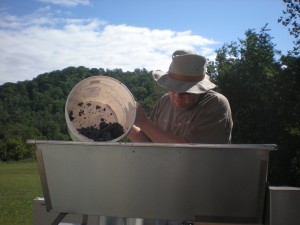
Here's the difference between a good harvest and a bad one -- how you pour the grapes into the crusher. 🙂
As Scott Elliff, owner of DuCard Vineyards said on a recent Saturday, this is what we’ve been working toward all year! This is the harvest – this is the fun part!
He was right. It was like a celebration. We (the Vineyard Goddess and me) spent that day at DuCard picking Cab Franc grapes with a dozen of our friends from viticultural classes at Piedmont Virginia Community College. And while it was work, it was also joyous fun. Continue Reading–>
In Search of a Few Good Vines
Now that we know what kinds of grapes we want to grow, it’s time to get down to the serious business of ordering vines and getting ready for spring planting. (Actually, this whole process has been serious business, but since the selection of grape varieties mostly involved visiting wineries and tasting wine, this part of the effort is serious in a somewhat different way.)
We began with some research on what clones have done well in Virginia. When you order vitis vinifera wines (which encompasses the European-style grapes most people are most familiar with, from Chardonnay to Cabernet Sauvignon), you’re making two decisions for each variety – the type of rootstock to use and the clone that will be grafted onto it. At a minimum, it’s important that rootstocks be resistant to such pests as phylloxera, the root louse that all but destroyed European vineyards in the 19thcentury, and nematodes, but we’re also looking for roots that will inhibit excessive growth, withstand cold winters, and work well in our soil, which is clay and loam. Long story short, we’ve pretty much decided to go with a root stock known as 101-14, the same root stock on the Cab Franc vines we’ve already planted in both the Fairfax and Nelson County vineyards.
Clones are more interesting, and they took a bit more time to figure out. Keep in mind that grape vines reproduce asexually. Cuttings from a Cab Franc are used to produce more Cab Franc
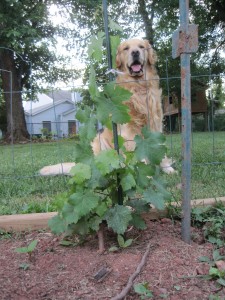
Here's a Cab Franc vine in the Fairfax vineyard (with Phoenix the Vineyard Dog standing guard) The clone is FPS 4, grafted onto 101-14 rootstock. The picture was shot a few months after planting.
vines, and it is presumed that the clone will exhibit the same qualities and characteristics as the vine it was taken from. But variations occur, and if a new vine exhibits differences that are deemed to be desirable, it may be characterized as a new clone and propagated more widely. So there isn’t just a single Viognier or a lone Cab Franc. There are a number of different Cab Francs, each classified as a separate clone, and each exhibiting different qualities, not just in the way they grow, but in the quality of the wine they produce.
So the choice of clones was very important to us. We relied heavily on Tony Wolf’s indispensible book,Wine Grape Production in Eastern North America, and came up with the following oddly-named clones (actually, all clones are oddly named; they sound a bit like the parts in an erector set) : For Cab Franc: ENTAV 214, 327, or 623 (whichever one we can get); for Petit Manseng: ENTAV 573; Petit Verdot, ENTAV 400, and Viognier: ENTAV 642. I mentioned Merlot in my last post, but we’ve pretty much decided that’s a clone too far for this year.
You can see that the clones we are most interested in all have the word ENTAV in their name. ENTAV (which stands for, Etablissement National Technique pour l’Amelioration de la Viticulture, or National Educational Association for Viticultural Improvement) are grapes of French origin, and sold in the United States through licensed nurseries. (By contrast, the clones we purchased early this year, referenced in the caption above, are FPS, which stands for Foundation Plant Services, the UC-Davis department that produces, tests, maintains and distributes premium foundation-level virus & disease-tested plant materials for use by California nurseries.)
We called one of the nurseries a few days ago, assuming that when we told them we planned to order a whopping 125 vines that they would fall all over themselves to help us, perhaps even offering to fly us out to California to get a look at the nursery. (You know I’m kidding, right? I would guess that their average order is measured in multiples of a thousand vines.) Our actual assumption is that we’d be able to get someone on the phone who could talk to us for a couple of minutes and then take our order and credit card number.
The nursery was Sunridge, which seems to be one of the very best in California, and the woman who worked with us could not have been friendlier or more helpful. Unfortunately, they didn’t have most of what we wanted. It turns out that they didn’t develop most of what we wanted “on spec” this year.
“On spec” seems to mean roughly the same thing in the grape vine nursery business as it does in the housing industry, where developers either build to order for a buyer who puts money down in advance, or build on spec in the hopes that buyers will show up with cash in hand. Whatever the case, they had the Viognier clones, but nothing else among our favorites.
Okay, that was a surprise. We had just assumed that everything on the web site would be immediately available and that all we had to do was call and ask for what we wanted. Now we are wondering if we will have to settle for clones that aren’t exactly what we want or wait another year to get clones of our dreams. Given that it takes a minimum of three years before the vines begin producing grapes, and a year or more after that before the wine is ready to drink, you only have so many chances in a single lifetime to get it right. And in our case, we only have so much land to devote to this enterprise. Putting off the planting for a year is not an option.
My wife, the Vineyard Goddess, sprang into action, and promptly identified a number of nurseries that distribute the varieties of grapes that we’re looking for. Great news! The bad news, however, was that only a handful sold the ENTAV clones we’re looking for.
We knew that there are only a limited number of ENTAV-approved nurseries in the United States, but we didn’t know how limited that number was. It turns out that only four nurseries in the U.S. are licensed to sell ENTAV clones, and two of them appear to have merged. Of the remaining two, one doesn’t have a web site, which is making it difficult to contact them, and the fourth has been a bit slow in getting back to us.
We think there might be other options, including Mercier California. According to the National Grape Registry, which is hosted by UC-Davis, Mercier has a presence in California. However, Mercier’s web site is tout en francias, and we are wondering if their ENTAV vines are shipped from France. Not that I care where they are shipped from. However, I do care about shipping costs. A friend who spent most of his life working vineyards in Bordeaux highly recommended Mercier, so we are hopeful that this is a viable option.
Okay, apparently purchasing vines isn’t as simple as logging into Amazon and selecting one-day shipping. But most of the things in life that are worthwhile require some extra work. And if anything warrants extra labor, it’s good wine. We’ll keep at it until we get it right. And with luck, we’ll be ordering those vines next week!
Introducing the Vines, Part II – Meet the Nelsons
It’s long past time to introduce the Nelson County vines, but before I start, let me once again acknowledge that it’s a bit of a stretch to refer to seven vines as a vineyard. But hey, it’s a stretch I’m willing to make. One is a vine, two or more is a vineyard, right?
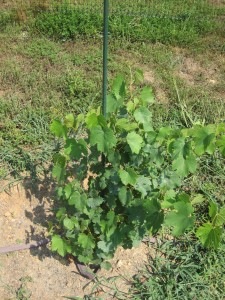
- “Nelson Mandela,” the tallest, noblest of our Cab Franc vines, named for one of the truly great figures of the 20th century.
The Nelson County property is the site for the real vineyard we plan to put in, and the seven vines we’ve planted fall into the category of experimental. As my wife, the Vineyard Goddess, puts it, we want to make our mistakes on these vines, so that we’ll know what we’re doing when we plant the main vineyard.
The vineyard itself is a small plot, surrounded by a deer fence, with five Cab Franc vines and two Mammolo Toscanos. The Cab Franc were purchased from Double A Vineyards, a nursery in New York state. They were ordered for delivery in the middle of April, a bit late in the season, but it took me a little time to get my arms around the idea that I could actually get everything done in time to plant vines this year. We ordered 12 in all, and the other seven were planted at our Fairfax property, where I thought I could keep a close eye on them. Continue Reading–>

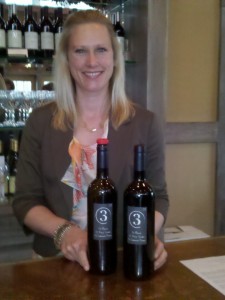
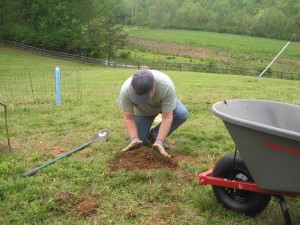
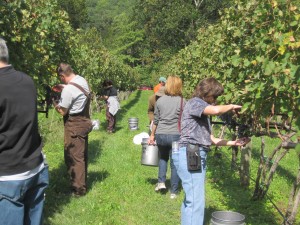
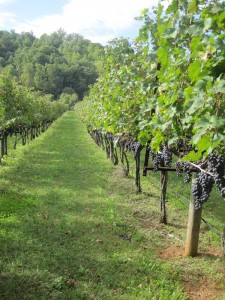
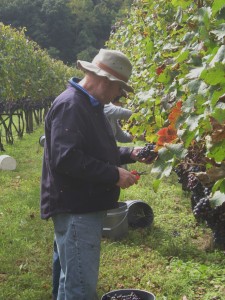
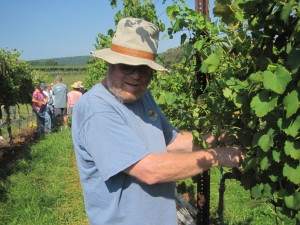
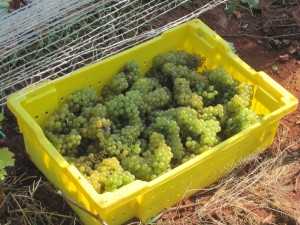
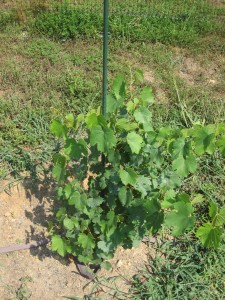
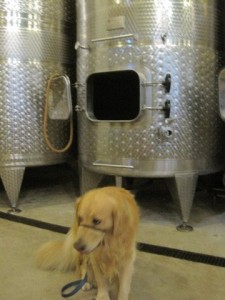


Recent Comments